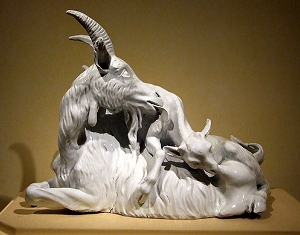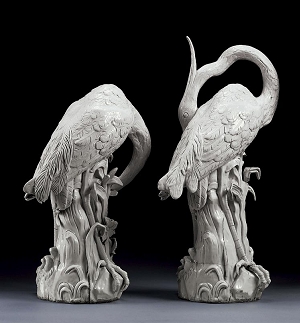Johann Joachim Kändler/Kaendler (1706-1775)
Biography
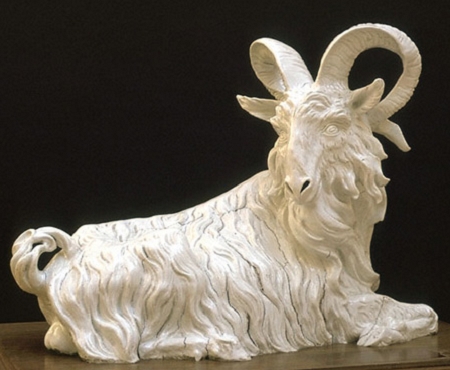 Goat, Meissen porcelain by Johann Joachim Kaendler, 1732. Augustus the Strong of Saxony (1670-1733) was a passionate collector of porcelain. He built his ‘Japanese Palace’ in the 1720s to house his vast collection of Far Eastern and Meissen porcelain. This goat is one of nearly 600 life-size animals and birds that he ordered from the Meissen factory for his porcelain menagerie, planned from 1730 onwards. In the event, technical problems and his death in 1733 led to the abandonment of the project before this number had been achieved.Johann Joachim Kändler/Kaendler/Kandler was the most important modelleur of the Meissen Porcelain Manufacture (Staatliche Porzellan-Manufaktur Meissen GmbH).
Goat, Meissen porcelain by Johann Joachim Kaendler, 1732. Augustus the Strong of Saxony (1670-1733) was a passionate collector of porcelain. He built his ‘Japanese Palace’ in the 1720s to house his vast collection of Far Eastern and Meissen porcelain. This goat is one of nearly 600 life-size animals and birds that he ordered from the Meissen factory for his porcelain menagerie, planned from 1730 onwards. In the event, technical problems and his death in 1733 led to the abandonment of the project before this number had been achieved.Johann Joachim Kändler/Kaendler/Kandler was the most important modelleur of the Meissen Porcelain Manufacture (Staatliche Porzellan-Manufaktur Meissen GmbH).
Kändler came on 15 June 1706 to the son of a pastor in Saxony Fischbach.
He grew up in a classically educated environment and therefore has an excellent knowledge of Greek mythology. This knowledge of craftsmanship and an excellent observation laid the foundation for Kändler later career, which was to carry them up to the court of Frederick II of Prussia.
The financial success of the porcelain artist it was quite parallel to the social advancement. But although he held on the end of his life on several properties and its own vineyard, he left behind at his death in 1775 much debt.
Kändler professional career began with the famous Dresden court sculptor and altar carver John Benjamin Thomae (1682-1751), where the pastor's son from Fischbach went into teaching. Even then he put a lot of skill and an exceptional grasp of the day, earning him at a young age responsible tasks. His talent did not go unnoticed.
On 22 June 1731 at the age of 25, he was recruited by the Meissen porcelain factory as a Modeler and he was appointed court sculptor by Augustus II the Strong.
There he worked first as a model champion, assistant of Johann Jakob Kirchner and succeeded him as "modelmaster" (head of the plastic mold design) in 1733 when Kirchner resigned. He became the Arcanist (from Latin arcanum, “secret”) who knew the secret of making porcelain which until 1707 was known only by the Chinese and Japanese. The highlight of his career was undoubtedly the appointment Hofkommissar (Court Commissioner) in 1749.
Later as a security clearance, he led the State Porcelain Manufactory by the turbulent period of Austria-Prussian wars and kept the production going against all odds.
In 1775 he died at Meissen after 45 years working there. He was succeeded by his assistants Johann Friedrich Eberlein and Peter Reinecke.
Relationship with Charles Frederick Kandler
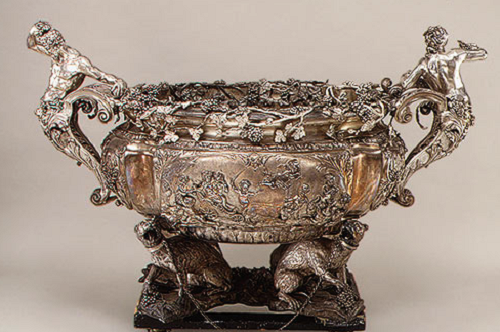 Wine Cistern by Charles Frederick Kandler, 1734. This was made for the Westminster Bridge Lottery however someone (probably Paul de Lamerie) sold it to Catherine the Great, Tzar of Russia, and it remains in the Hermitage Museum, the largest extant piece of antique solid silver in the world. It is a huge folly, and a beautiful one: utterly dispensable yet extraordinary. In 1734 Paul de Lamerie was called on to produce his two great Chandeliers in the Kremlin. Charles Frederick Kandlerwas the greatest silversmith in 18th century however "the identity remains mystery" said Arthur G. Grimwade. Some scholars think that he was a youger brother of Johann Joachim Kaendler.
Wine Cistern by Charles Frederick Kandler, 1734. This was made for the Westminster Bridge Lottery however someone (probably Paul de Lamerie) sold it to Catherine the Great, Tzar of Russia, and it remains in the Hermitage Museum, the largest extant piece of antique solid silver in the world. It is a huge folly, and a beautiful one: utterly dispensable yet extraordinary. In 1734 Paul de Lamerie was called on to produce his two great Chandeliers in the Kremlin. Charles Frederick Kandlerwas the greatest silversmith in 18th century however "the identity remains mystery" said Arthur G. Grimwade. Some scholars think that he was a youger brother of Johann Joachim Kaendler.
Johann lived in London and had his own premises at Jarmyn Street in mid 1730s. His youger brother came form Dresden in about 1727, and took over his elder brother's premises at Jermyn Street.
This highly important silversmith had the finest modeling skills and worked for Paul de Lamerie, the most famous silversmith. Some of De Lamerie's works from 1736 to 1745 are mentioned as the excellence of Rococo style in England. His works of arts surpassed all and he became known to be "Maynard Master".
The Development of Crafts
His models were heavy on rococo style, leading a porcelain trend of the day. He became the most famous of the Meissen sculptors.
Naturalistic Animal Figures
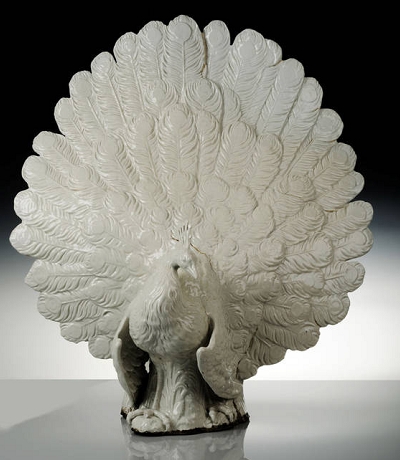 Bird of Paradice by Johann Joachim Kandler, 1742.His early porcelain animal groups show a powerful impression of the natural reaction under the influence of the Dresden sculpture. His menagerie of large-scale animals, left in the white, are some of the high points of European porcelain manufacture. His work resulted in the production of exquisite figurines in the rococo style that influenced porcelain making in all of Europe.
Bird of Paradice by Johann Joachim Kandler, 1742.His early porcelain animal groups show a powerful impression of the natural reaction under the influence of the Dresden sculpture. His menagerie of large-scale animals, left in the white, are some of the high points of European porcelain manufacture. His work resulted in the production of exquisite figurines in the rococo style that influenced porcelain making in all of Europe.
His early porcelain animal groups show a powerful impression of the natural reaction under the influence of the Dresden sculpture.
The Japanese Palace/Japanisches Palais, which was enlarged in Baroque and neo-classical style in 1727-37 under the direction of M. D. Pöppelmann, is richly decked with chinoiserie. Originally built to house Augustus the Strong's collection of porcelain.
In 1730 Augustus the Strong (1694/7-1733), Elector of Saxony and King of Poland, one of the wealthiest monarchs and most important patrons of the arts of his age, planed to fill the upper floor of the Japanese Palace with a large group of porcelain animals and birds made by the Meissen Porcelain factory.
The ambition of Augustus's project cannot be overemphasised, and it still remains unparalleled in the history of ceramics. The order for these large beasts came only 20 years after the foundation of the Meissen factory, the first European factory to succeed in the manufacture of 'true' (or hard-paste) porcelain of the Chinese type. Meissen's discovery of the means of making porcelain was the direct result of Augustus the Strong's passion for imported Far Eastern wares, which led him to amass a collection of over 20,000 pieces (among them 151 Chinese vases exchanged for a unit of 600 cavalrymen), and to employ, and briefly imprison, the alchemist J. F. Böttger to discover the formula for this 'white gold'.
The size of the project is also extraordinary. According to a list of 1734 as many as 597 animals and birds were projected for the palace. Most were to have been produced in editions of eight from moulds made from original models provided by the sculptors discussed below. While in the event this quantity of figures was not realised, an inventory lists as many as 458 examples at Dresden in 1736, but many were much smaller birds and animals than this piece. Not surprisingly, their production became such a drain on the factory’s output and resources that work on the scheme was abandoned sometime before 1739.
Swan services
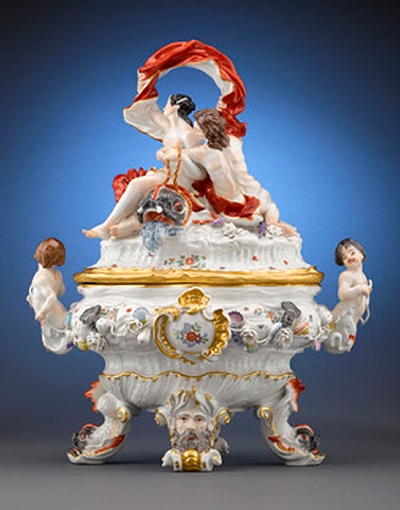 Tureen from Swan Services by Johann Joachim Kandler, 1737.In 1710, Augustus the Strong, Elector of Saxony and King of Poland (1670-1733), established a porcelain factory after two of his workers discovered the formula for hard-paste porcelain—a coveted secret previously known only in China and Japan.
Tureen from Swan Services by Johann Joachim Kandler, 1737.In 1710, Augustus the Strong, Elector of Saxony and King of Poland (1670-1733), established a porcelain factory after two of his workers discovered the formula for hard-paste porcelain—a coveted secret previously known only in China and Japan.
Located in Meissen (in what is now Germany), the factory was placed under the supervision of the prime minister, Heinrich, Count von Bruhl (1700-1763), in 1733. Von Bruhl soon arranged for the production of a magnificent dinner service that would bear his coat of arms. Four years in the making from 1737 to 1741, this famous set—known as the Swan Service—originally contained more than 2,200 pieces and remained in the possession of his family until after the Second World War.
The Swan Services embossed decoration on plates depicted swans floating on water surrounded by water plants and bullrushes. The tureens were in the shapes of enormous shells adorned with mermaid handles and the oil and vinegar cruets, took the form of little putti riding swans. Its new style of floral decoration, inspired by the work of Japan's wonder ceramicist Sakaida Kakiemon
酒井田柿右衛門 (1596-1666) would in the end become a wholly new European concept.
The Swan Service was made between 1737 and 1741 by Johann Joachim Kändler with an assistant Johann Friedrich Eberlein.
Characters from the Italian Commedia dell’Arte
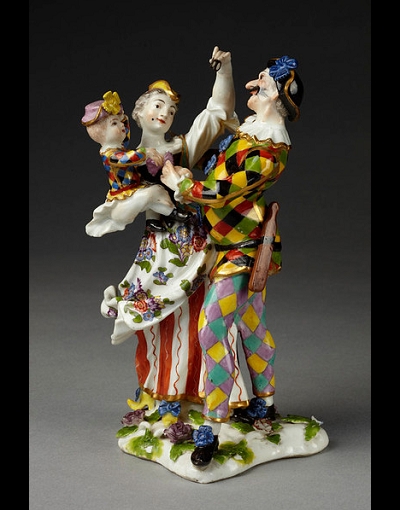 Harlequine Columbine and their child by Johann Joachim Kandler, 1745.The best known of all Kandler’s works are his figurines of characters from the Italian Commedia dell’Arte which are among the best works of this kind. They include Harlequin, Columbine and Pierrot, All his figures were engaging and delightful. The production was enormous – more than a thousand different subjects in all including people, animals, mythological and allegorical pieces.
Harlequine Columbine and their child by Johann Joachim Kandler, 1745.The best known of all Kandler’s works are his figurines of characters from the Italian Commedia dell’Arte which are among the best works of this kind. They include Harlequin, Columbine and Pierrot, All his figures were engaging and delightful. The production was enormous – more than a thousand different subjects in all including people, animals, mythological and allegorical pieces.
Out of more than a thousand different designs, especially stands out in 1753 created the monkey chapel, Kändler had seen as a metaphorical rejection of any compulsion. This homage to the Enlightenment ideal of free and rational people, he met the spirit and created a timeless masterpiece of European porcelain. The monkeys band to this day not lost its popularity and continues to be reproduced. Kändler of the Crucifixion is in the castle church Lauchhammer-West.
Works of Art
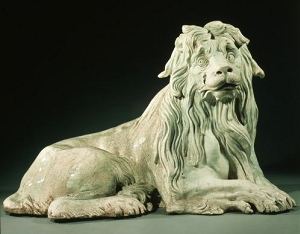 Lion by Kirchner, Meissen, 1731. Lion by Kirchner, Meissen, 1731. |  Goat_1732, Meissen. Victoria & Albert Museum. Goat_1732, Meissen. Victoria & Albert Museum. |
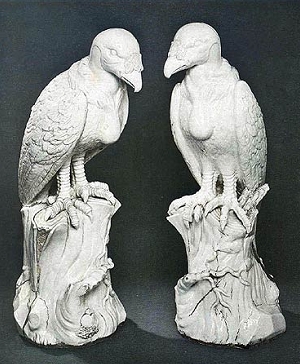 King Vulture, 1732, Meissen. Victoria & Albert Museum. King Vulture, 1732, Meissen. Victoria & Albert Museum. | 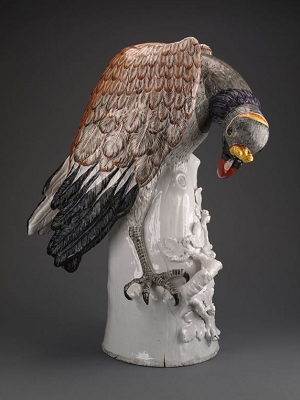 King Vulcher, Johann Joachim Kaendler, Meissen, 1732. The Art Institute of Chicago. King Vulcher, Johann Joachim Kaendler, Meissen, 1732. The Art Institute of Chicago. |
 Padua Cock, Johann Joachim Kaendler, Meissen, 1732. Padua Cock, Johann Joachim Kaendler, Meissen, 1732. |  Parrot, Johann Joachim Kaendler, Meissen, 1732. Parrot, Johann Joachim Kaendler, Meissen, 1732. |
 Bird of Paradise, 1740, Meissen. Bird of Paradise, 1740, Meissen. |
 Butter Dish shaped like a Rhinocerous, 1745, Meissen. The Hermitage Museum. Butter Dish shaped like a Rhinocerous, 1745, Meissen. The Hermitage Museum. | 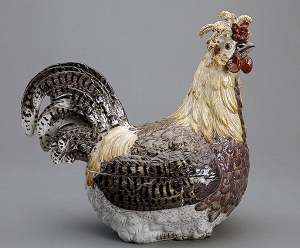 Bowl shaped like a Paduan Cock, 1770, The Hermitage Museum. Bowl shaped like a Paduan Cock, 1770, The Hermitage Museum. |
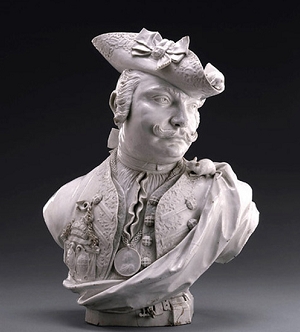 Baron Schmid I, 1740, Meissen. Baron Schmid I, 1740, Meissen. |
 Swan Service Tureen, 1736, Meissen. Swan Service Tureen, 1736, Meissen. | 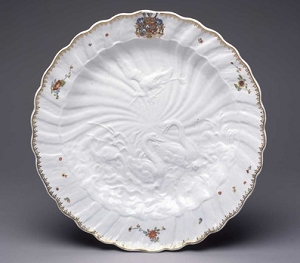 Swan Service Plate, 1736, Meissen. Swan Service Plate, 1736, Meissen. |
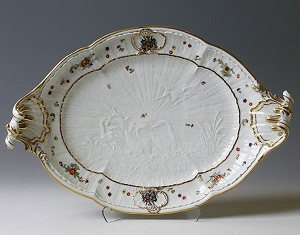 Swan Service Tray, 1735, Meissen. The Hermitage Museum. Swan Service Tray, 1735, Meissen. The Hermitage Museum. |
 Appolo, 1745, Meissen. The Hermitage Museum. Appolo, 1745, Meissen. The Hermitage Museum. |  Muse of Lyric Song, 1745, Meissen. The Hermitage Museum. Muse of Lyric Song, 1745, Meissen. The Hermitage Museum. |
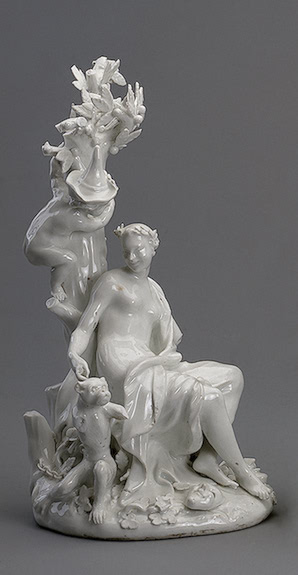 Thalia Muse of Commedy, 1745, Meissen. The Hermitage Museum. Thalia Muse of Commedy, 1745, Meissen. The Hermitage Museum. | 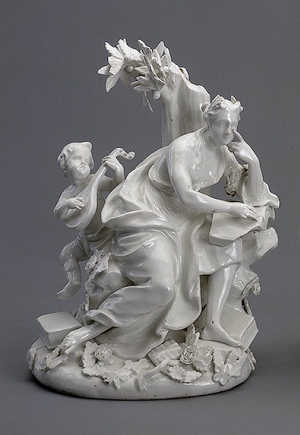 Calliope Muse of Epic Poetry, 1772, Meissen. The Hermitage Museum. Calliope Muse of Epic Poetry, 1772, Meissen. The Hermitage Museum. |
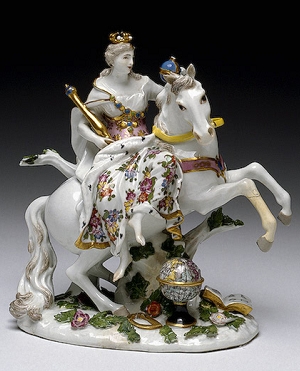 Allegorical figure of Europe, 1745, Meissen. The Hermitage Museum. Allegorical figure of Europe, 1745, Meissen. The Hermitage Museum. | 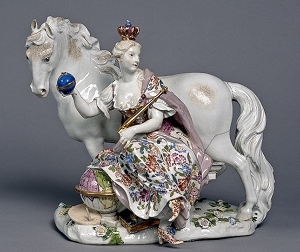 Allegorical figure of Europe, 1746, Meissen. The Hermitage Museum. Allegorical figure of Europe, 1746, Meissen. The Hermitage Museum. |
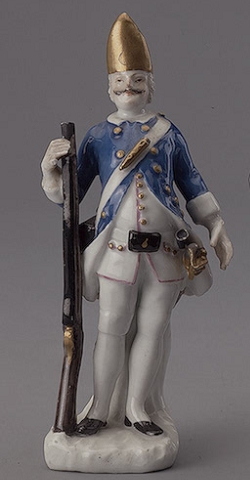 Saxonial Grenadier with a Musket, 1745, Meissen. The Hermitage Museum. Saxonial Grenadier with a Musket, 1745, Meissen. The Hermitage Museum. | 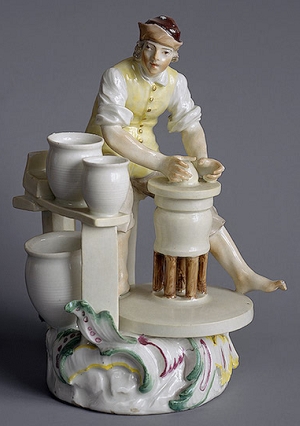 Potter, 1750, Meissen. The Hermitage Museum. Potter, 1750, Meissen. The Hermitage Museum. |
 Harlequine Columbine and Their Child, 1745, Meissen. The Hermitage Museum. Harlequine Columbine and Their Child, 1745, Meissen. The Hermitage Museum. | 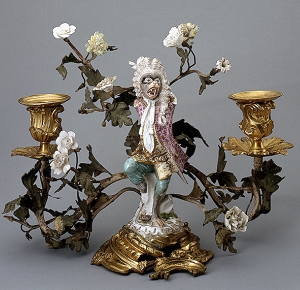 Candlestic Monkey Conductor, 1753, Meissen. The Hermitage Museum. Candlestic Monkey Conductor, 1753, Meissen. The Hermitage Museum. |
 Candlestic Monkey Drummer, 1753, Meissen. The Hermitage Museum. Candlestic Monkey Drummer, 1753, Meissen. The Hermitage Museum. |  Candlestick Monkey Violinist, 1753, Meissen. The Hermitage Museum. Candlestick Monkey Violinist, 1753, Meissen. The Hermitage Museum. |
 Monkey Musicians, 1753, Meissen. The Hermitage Museum. Monkey Musicians, 1753, Meissen. The Hermitage Museum. |  Catherine II wearing Preobraxhensky Regiment, 1770, Meissen. The Hermitage Museum. Catherine II wearing Preobraxhensky Regiment, 1770, Meissen. The Hermitage Museum. |
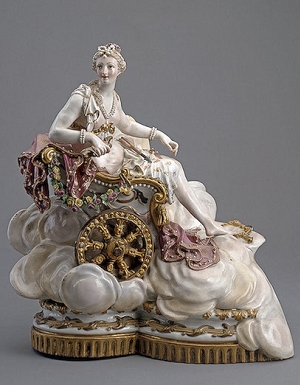 Venus Riding a Chariot, 1774, Meissen. The Hermitage Museum. Venus Riding a Chariot, 1774, Meissen. The Hermitage Museum. |  Allegory of Trade, 1772, Meissen. Allegory of Trade, 1772, Meissen. |
|
|
 Top
Top Site Map
Site Map References
References About Me
About Me